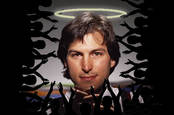This article is more than 1 year old
Ex-Apple engineer lifts lid on Uncle Sam's top-secret plan to turn customized iPod into 'Geiger counter'
This article will self-destruct in five seconds
A former Apple engineer has spilled the beans on what he's described as a top-secret project Cupertino conducted with the US government in the 2000s.
David Shayer, a former engineer with Apple's iPod outfit, this week recounted the yarn of how he came to build a custom bit of kit for the US Department of Energy (DOE) in 2005.
As these things tend to go, Shayer doesn't have much in the way of details on the project, other than claiming that the whole thing was an effort to attach or add something like a Geiger counter to an iPod so as to covertly detect and record radioactive materials.
The former Apple code jockey said that, back then, he was tapped by a senior Apple boss to chaperone two government contractors, chaps named "Paul and Matthew" who worked for engineering outfit Bechtel. The pair, it is said, were tasked with creating a customized version of the iconic Apple media player that could not only deliver music and video, but also hold or use some mysterious specialist hardware. The purpose, Shayer reckons, was to create a discrete Geiger counter that could also pass as a media player.
"Something that DOE agents could use without furtively hiding it," Shayer wrote. "Something that looked innocuous, that played music, and functioned exactly like a normal iPod. You could walk around a city, casually listening to your tunes, while recording evidence of radioactivity — scanning for smuggled or stolen uranium, for instance, or evidence of a dirty bomb development program — with no chance that the press or public would get wind of what was happening."

On the seventh anniversary of Steve Jobs' death, we give you 7 times he served humanity and acted as an example to others
READ MORE"We discussed the best way to hide the data they recorded. As a disk engineer, I suggested they make another partition on the disk to store their data," he added. "That way, even if someone plugged the modified iPod into a Mac or PC, iTunes would treat it as a normal iPod, and it would look like a normal iPod in the Mac Finder or Windows Explorer. They liked that, and a hidden partition it was.
"After a few months of on-again, off-again work in their requisitioned office, Paul and Matthew finished integrating their custom hardware into the iPod and wrapped up the project."
Interestingly, the story paints a picture of Apple having stricter security than the government. The suits were not allowed on the company network, couldn't get an internal Wi-Fi connection, and weren't allowed to walk off with the source code of the project they were working on.
"I gave them a copy of the current source code on a DVD and explained it couldn’t leave the building," Shayer said. "Ultimately, they were allowed to keep the modified copy of the iPod OS they built, but not the source code for it.
"Only employees cleared for our building were allowed in," he recounts. "On each floor, there was another locked door and badge reader, and only people cleared for that floor were allowed in. Whenever I asked Paul and Matthew what they were building, they changed the subject and started arguing about where to go for lunch. Standard geeks."
Apple did not return a request for comment, and if Shayer is to be believed, it is not going to talk about it. "Only four people at Apple knew about this secret project. Me, the director of iPod Software, the vice president of the iPod Division, and the senior vice president of Hardware," he said. "None of us still work at Apple. There was no paper trail. But now you know." ®
